Let’s learn the purpose and how to create Scorecard charts in Google Sheets.
Scorecard chart is a newly introduced graph in Google Sheets. What’s the purpose of it?
The purpose of the Scorecard charts in Google Sheets is to call special attention to (key) performance indicators aka KPIs. For example;
- Call attention to total new contracts signed in January (or in any month).
- Display the organic traffic to your blog during the first quarter of the year.
- Comparison of total sales in the first half and the second half of the year.
In Google Sheets, you can use Slicers to control the Scorecard chart like any other chart. All that information I have included in this tutorial.
Let’s start this tutorial by creating a basic Scorecard chart.
How to Create Scorecard Charts in Google Sheets
To insert a Scorecard chart in Docs Sheets, follow the below instructions.
Assume your data range is A1:C. Click any cell outside the range preferably a cell in column E.
I am skipping column D to avoid an adjoining cell to the data range. This will help you to create a fresh blank chart, I mean to start creating a chart with no Google Sheets suggested chart.
For example, I want to create a Scorecard chart in Google Sheets based on this sample Flash report.
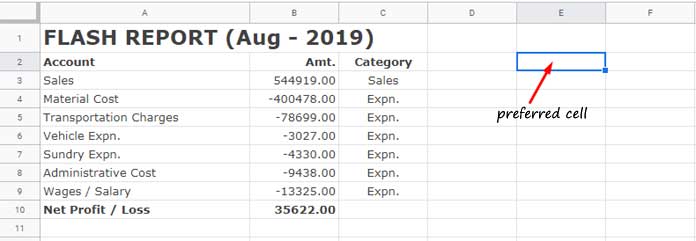
Click on the cell E2. Then go to the ‘Insert’ menu and click on ‘Chart’. This will instantly open the ‘Chart editor’ panel.
Under ‘Chart type’ select Scorecard chart. This will open a ‘No data’ blank chart in your Google Sheets Spreadsheet.

Google Sheets Chart Menu and Chart Panel
Now time to look into the important settings in this chart. Let’s create a Scorecard chart using the above Flash report data.
What I am going to do is to call attention to the net profit/loss value in cell B10. On the course, you can understand all the essential settings in Google Sheets Scorecard Chart Panel.
KEY VALUE – The Value to Call Attention
Call Attention to a Single Cell Value
On the chart editor panel, under the ‘Setup’ tab, scroll down to see the ‘KEY VALUE setting.
The Key value is the value to call attention. Click on it and select the cell B10 and click OK. You have created your first Scorecard Chart.
Note: You can remove the cell reference E2 (active cell) from the data range under the ‘Setup’ tab.
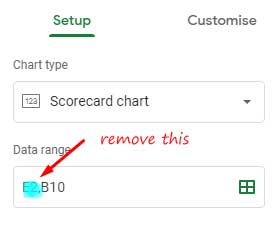
Click on the ‘Customise’ tab and scroll down. Click on ‘Chart axis & settings’. Under the ‘Title text’ field, type “Net Profit / Loss”.
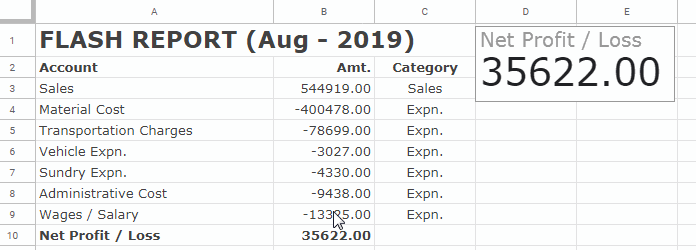
This method you can adopt to call attention to a key point indicator like total sales in January or total contracts signed in January likewise. Because the above Scorecard chart only involves value in a single cell.
What about using a range in the Scorecard chart in Google Sheets?
Call Attention to a Range – Aggregated Values
To plot a Scorecard graph with a range reference, you can follow all the steps except the KEY VALUE detailed above. Here are the changes/addition to the above steps.
Note: Here I am using a different set of data. Please see the image below.
- Select the range B2:B4 under the KEY VALUE instead of selecting a single cell.
- Toggle the Aggregate button below that and choose the function you want.
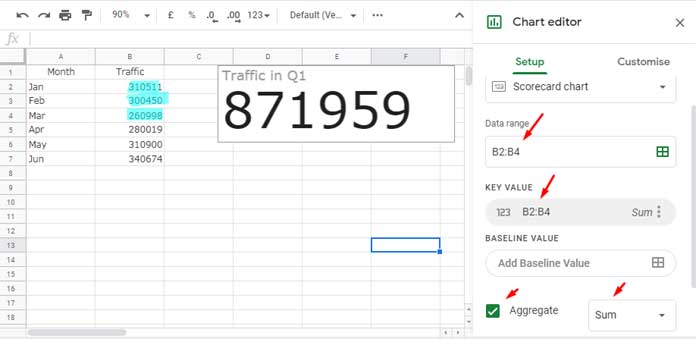
Here the data is about the monthly website/blog traffic (monthly visitors) for the first two quarters. The Scorecard card chart displays the sum of the values (total visitors) in quarter 1.
Aggregation in Scorecard Chart in Google Sheets
You can choose Average, Count, Max, Median, Min, and Sum functions in this chart. To view the option to choose any of these functions, the KEY VALUE must be a range as shown in the above example.
The aggregation functions are useful in many scenarios like;
- To display the average/sum of the sales in Q1, Q2, Q3, and Q4.
- The Max function to display the maximum traffic during a period.
- The Count of transactions during a month and so on.
BASELINE VALUE – to Show Changes When Comparing Two Data Ranges
Let’s take the above website traffic data for example. In the same chart, you can add baseline values.
Under the KEY VALUE click on BASELINE VALUE and add the range B5:B7. Here also you should choose the function SUM.
The chart will compare the quarter 1 total with quarter 2 total. The difference will be shown on the chart (Absolute change).
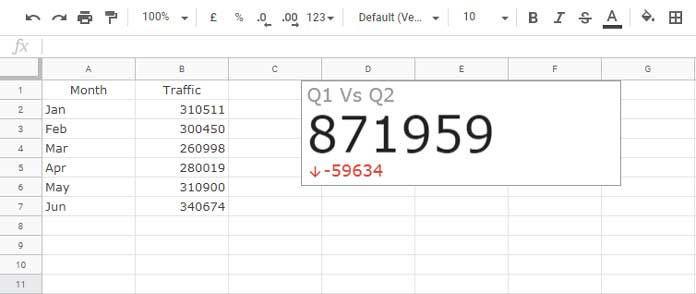
The difference here is -59634. That means Q1 total, which is 871959, is less than 59,634 to Q2 total. Q2 total is 931593.
=871959-931593On the chart editor ‘Customise’ panel, you can customize this baseline value.
I mean you can show the difference in percentage. For that select Customize > Baseline value > Percentage change.
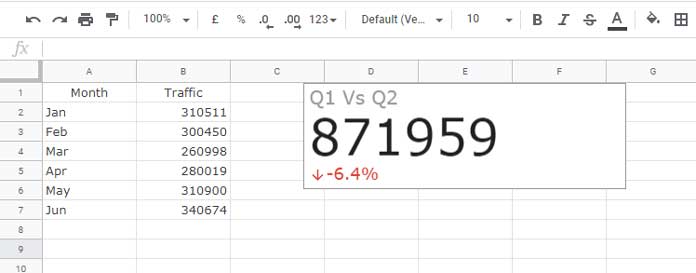
Control Google Sheets Scorecard Chart with Slicers
In an earlier tutorial, I have elaborated on how to use Google Sheets Slicers. So I am not going into that again. Please read that tutorial here – How to Use Slicer in Google Sheets to Filter Charts and Tables.
To get the sample data used there, copy this Sheet.
In the copied Sheet, open the tab “Copy of Dashboard” to see the Scorecard chart and two slicers.
The Scorecard chart displays the sum of ‘Qty. in Gallon’ from Sheet1 column C.
The Scorecard chart settings are as follows (you can check that yourself there).
Data range: Sheet1!C2:C25
Key-Value: Sheet1!C2:C25
Since an array/range involved, I have toggled the “Aggregate” button and choose the function Sum.
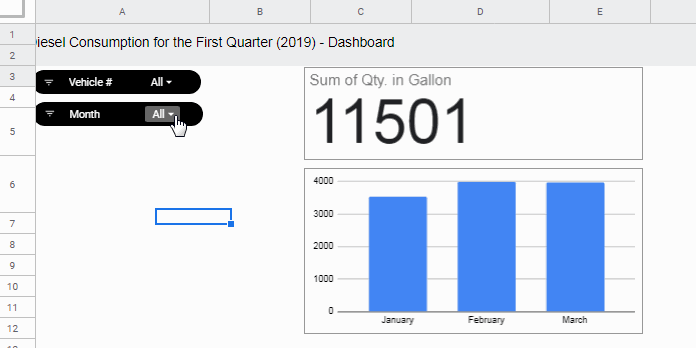
See how the Slicers controlling the Scorecard chart in Google Sheets.






















Hi all!
My Sheet is very long, with plenty of cells down.
I’d like my Scorecard (I just discovered it, very cool!) to be always visible.
I tried freezing some lines at the top. When I scroll down, I lose it.
I’m wondering if there is a way to make it visible all the time.
Thanks in advance!
Hi, Manuel Bellsolell,
At present, Google Sheets doesn’t offer that feature.
Is there a way to show both the Absolute change and the Percentage change at the same time when comparing two data ranges?
Hi, Dan Lee,
Here is a workaround.
Two Baseline Values in a Scorecard Chart in Google Sheets (Workaround)